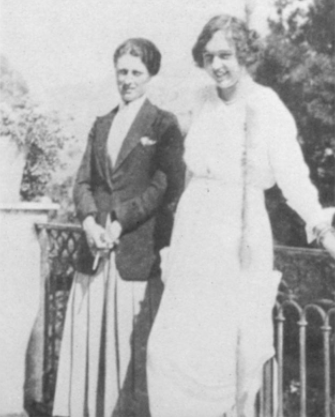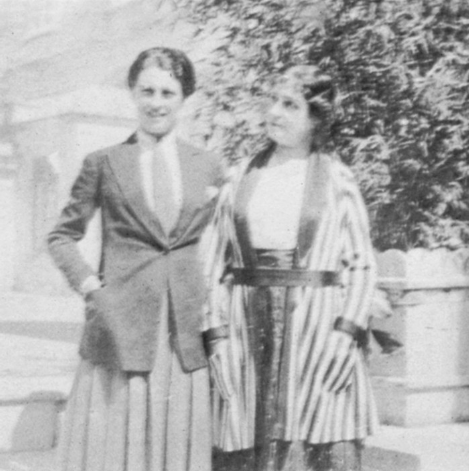

Partner Francesca Lloyd
Queer Places:
Cimitero Ebraico, Via Marco Polo, 55049 Viareggio LU
 Maria "Mimì" Franchetti (May
13, 1893 - April 29, 1943) lived in Capri with her own
friend Francesca Lloyd (Checca
or Frances), who was hopelessly, and to no avail, in love with her. A
fictional character in Extraordinary Women by
Compton Mackenzie. All Natalie Clifford Barney circle knew the characters' identities
of the Ladies Almanack, which Barney uncoded in her copy of the text (now in the Bibliotheque Doucet). For example, Cynic Sal is
Romaine
Brooks, Barney's friend and lover of many years;
Janet Flanner and
Solita Solano appear as the journalists Nip and Tuck;
Radclyffe Hall and her lover
Una, Lady Troubridge
are the British couple Tilly Tweed-in-Blood and Lady Buck-and-Balk; the heterosexual Patience Scalpel is
Mina Loy; Doll Furious is Oscar Wilde's niece
Dolly Wilde; Senorita Fly-About is Mimi Franchetti, Bounding Bess is
Esther Murphy.
Maria "Mimì" Franchetti (May
13, 1893 - April 29, 1943) lived in Capri with her own
friend Francesca Lloyd (Checca
or Frances), who was hopelessly, and to no avail, in love with her. A
fictional character in Extraordinary Women by
Compton Mackenzie. All Natalie Clifford Barney circle knew the characters' identities
of the Ladies Almanack, which Barney uncoded in her copy of the text (now in the Bibliotheque Doucet). For example, Cynic Sal is
Romaine
Brooks, Barney's friend and lover of many years;
Janet Flanner and
Solita Solano appear as the journalists Nip and Tuck;
Radclyffe Hall and her lover
Una, Lady Troubridge
are the British couple Tilly Tweed-in-Blood and Lady Buck-and-Balk; the heterosexual Patience Scalpel is
Mina Loy; Doll Furious is Oscar Wilde's niece
Dolly Wilde; Senorita Fly-About is Mimi Franchetti, Bounding Bess is
Esther Murphy.
Maria Franchetti was born in Milan, the daughter of the Venetian Baron Alberto Franchetti (born 1860), a composer, son of Baron Raimondo Franchetti Sr (1829-1905) and by Sara Luisa Rothschild (1834-1924). In 1888, the year of his debut in opera, Alberto Franchetti married in Reggio Emilia, Margherita Levi (born 1865). Another child, Guido Franchetti, was born on December 28, 1895 and died in Belgium in 1918/19 as a result of the Spanish flu. A third child was Raimondo Franchetti Jr, explorer. The Franchetti divorced in 1897 in Munich. After having composed many works in the period 1888-1924, towards the end of the 1920s Alberto Franchetti retired to private life and died almost forgotten in Viareggio, where he was buried in the local Jewish cemetery.
Compton Mackenzie remembered Franchetti arrival at the Quisisana in May 1918 with ‘short accordion-pleated skirt … rifle green jacket and waistcoat, her double collar and black satin tie with coral pin, her long jade cigarette holder and slim ebony stick and … rippling hair lustrous and hatless’. Most lesbian travellers would call on the Principessa Helène Soldatenkov, who had been living for many years at the Villa Siracusa in Sorrento, across the sound from Capri, waited on by an all-female staff. Her many lovers were ‘governesses’ to her daughter, who was also called Helène but known as ‘Baby’. Mimì Franchetti succeeded in seducing the previously heterosexual Baby Soldatenkov, a matter which gave her mother, too, great satisfaction. (Compton Mackenzie wrote about them all in Extraordinary Women.)

Mimì Franchetti and Checca Lloyd
Renata Borgatti fell in love with one woman after another. In 1918 it was Mimì Franchetti; in 1919 Romaine Brooks. Franchetti's arrival had thrown the lesbian world of Capri into commotion. Franchetti, in fact, was stupendously egocentric, unable to keep herself from interfering in any relationship between two other women for the sole purpose of testing her own attractions. Borgatti, given the state of her dissatisfaction with her friendship for Riola, could not but be easily fascinated by Franchetti. Their tempestuous and impassioned relationship lasted about a year. Meanwhile, Franchetti was living in Capri with her own friend Francesca Lloyd, who was hopelessly, and to no avail, in love with her. The relationship between Franchetti and Lloyd paralleled that of Borgatti and Franchetti – flying bottles, furious quarrels, separations, reconciliations and rare periods of harmony. Franchetti, an untameable femme fatale, was long the moving spirit behind lesbian parties in Capri, during one of which, when she was completely inebriated, she almost fell off the cliff above the Villa Solitaria. She continued to be surrounded by women who were madly in love with her.
Borgatti, however, in 1919, took up with Romaine Brooks, then aged 45, who painted an intense portrait of Renata Borgatti at the Piano. Franchetti then tried, without success, to conquer Brooks, who possessed such fame and charisma that any girl able to spark her interest boasted that this was almost like being loved by Sappho herself! However, Brooks's interest in Borgatti was shortlived; the year after they met, Brooks was already writing to Natalie BARNEY that she was trying to avoid a visit by Borgatti and no longer had any intention of aiding her financially.
Natalie Clifford Barney had an affair with Mimì Franchetti. It wasn't a particular serious affair. Barney once offered a list of her primary relationships, divided into liasons, demi-liasons, and adventures. The relationship with Franchetti is mentioned as an adventures. During the time she became involved with Franchetti, she had also a liasons with Liane de Pougy, a long-term relationship with Romaine Brooks and was in a similar long-term relationship with Elisabeth de Gramont. Confident that the fling with Franchetti was no more than a pleasant interlude, Barney invited Pougy to share her bed and her new lover in a three-way relationship that quickly got out of hand. Franchetti appears thinly veiled in Women Lovers by Natalie Clifford Barney under the initial M. and de Pougy is L. This long-lost novel recounts a passionate triangle of love and loss among three of the most daring women of belle époque Paris. In this barely disguised roman à clef, the legendary American heiress, writer, and arts patron Natalie Clifford Barney, the dashing Italian baroness Mimi Franchetti, and the beautiful French courtesan Liane de Pougy share erotic liaisons that break all taboos and end in devastation as one unexpectedly becomes the “third woman.” When Franchetti and Pougy fall in love, they exclude Barney and the love triangle falls apart. De Pougy depicts her subsequent love affair with Franchetti from her perspective in My Blue Notebooks: Nathalie and Mimì made much of me, they took me out, they dressed my wounds. Mimì and I loved each other. Her presence was my heaven of joy and forgetfulness. Natalie became jealous.
The real-life complexities of all these relationships are stunning—Mimi Franchetti had an affair with Elisabeth de Gramont in 1924 and Romaine Brooks and Mimi Franchetti had an affair in the spring of 1925, right before the events of the novel Women Lovers. In addition, Liane de Pougy and Elisabeth de Gramont were briefly together. According to biographer Rapazzini, rumor had it that Brooks and de Gramont may also have had an affair.
In 1925 Faith Mackenzie met Mimì Franchetti at one of Romaine’s parties, ‘no longer as slim as a hamadryad … said to be writing poetry … her charm undiminished’.
Extraordinary Women is Compton Mackenzie's novel published in 1928. The plot deals primarily with the romance between Rosalba Donsante (in real life Mimì Franchetti) and Rory Freemantle (the book's only composite character), although other minor characters play a role within the novel as a whole.
Diana Souhami writes about Barney and Franchetti touring the "lesbian clubs," including Le Select. Also Una Troubridge frequented Le Select with Radclyffe Hall.
Mimì Franchetti died in Cannes on April 29, 1943.
My published books: